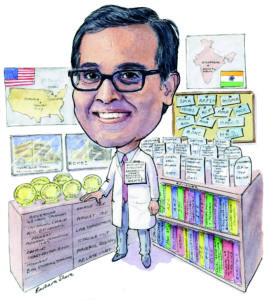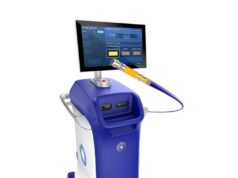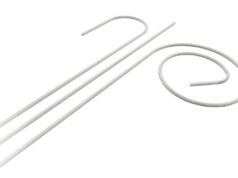 Dhanunjaya Lakkireddy is executive medical director at The Kansas City Heart Rhythm Institute at HCA Midwest Health, Kansas, USA. He holds the title Professor of Medicine, is board certified in Cardiology and Electrophysiology and is a renowned electrophysiologist. He spoke to Cardiac Rhythm News about the impact his family doctor had on his life, and his most memorable patient cases
Dhanunjaya Lakkireddy is executive medical director at The Kansas City Heart Rhythm Institute at HCA Midwest Health, Kansas, USA. He holds the title Professor of Medicine, is board certified in Cardiology and Electrophysiology and is a renowned electrophysiologist. He spoke to Cardiac Rhythm News about the impact his family doctor had on his life, and his most memorable patient cases
When did you first decide you wanted a career in medicine?
I decided that I wanted to be a doctor when I was in high school. Our family doctor had a profound impact on my leanings toward medicine. I remember, during high school, I contracted malaria. The doctor ordered an ice bath which, after three hours, controlled my body temperature. This reaffirmed my respect and fascination for the profession. The knowledge and compassion of our family physician Madhuvardhan Reddy left a lasting impression on me.
Why did you choose to specialise in atrial fibrillation and complex arrhythmias?
I always liked cardiology as the most dynamic field with a lot of creativity and innovation driving the science forwards. When I was in medical school interventional cardiology was still spreading its wings and acute percutaneous coronary intervention was just taking a foot hold in India. All through residency I thought I was going to be an interventionalist but in my first month during general cardiology fellowship I was fortuitously asked to switch my rotation to electrophysiology (EP) since the assigned fellow had a family emergency. I started working with Huagui Li who was absolutely fantastic. He took me under his wing and taught me a lot about electrophysiology. By the end of the month I was placing pacemakers, implantable cardiac defibrillators (ICDs) and floating catheters. The very idea that one can actually ablate around the pulmonary veins and stop atrial fibrillation was mind-boggling. I thought that was the coolest thing in the world. The complexity of AF origin and maintenance all of a sudden seemed surmountable. The field was so young and the opportunity to advance it further was very exciting. The tools at the time were very clumsy and each case would take 6–8 hours but, at the end, patients going home in sinus rhythm was exhilarating. While my other colleagues in the fellowship hated long cases in EP, it became very appealing to me. By the end of the three months into the fellowship, I found my calling.
Who were your mentors and what influence did they have on your career?
I had several mentors at every stage of my life. I would not have come this far without their support, kindness, and guidance. During high school, Sisters Mabel and Emy, Mrs Gowri, Jaganmohan Rao and Anjireddy sowed the seed of interest in life sciences and importance of staying focused. Professors Annapurna, Habeebullah and Rangareddy during medical school helped me learn the basic tenements of the art and science of medicine. Later during residency James Vacek and Manohar Gowda shaped my interest in cardiology further. My interest in cardiovascular research was fostered by these two wonderful people whom I am indebted to. During cardiology fellowship Huagui Li and Syed Mohiuddin at Creighton have provided with further clarity and direction leading up to my career in electrophysiology. Andrea Natale and Sanjeev Saksena have been impactful on my career as an EP. Natale has been an inspiring influence on my career as an electrophysiologist. His leadership in clinical program building, high quality research and education has rubbed on all of us who were his fellows. My training years were very exciting with all the new developments in complex arrhythmia ablations, device extractions, robotic navigation and more. Saksena has taught me the lessons of life and the importance of work life balance. He is someone I always reach out to when making a life decision. Arun Kolli who was one year ahead of me from junior college through EP training has been an amazing source of guidance and fellowship. My parents and brothers have been a great influence on my personal and professional accomplishments. My wife Madhuri has been an unfettered supporter and stabiliser in my life.
What is your most memorable patient case?
I can say there are probably several, of which two cases stand out.
One was from the Spring of 2005: A 56-year-old patient with ventricular tachycardia (VT) storm. Bob Schweikert was the attending physician. We started the case around 7:30 pm. There were five different VTs, the Impella was not available at that time. We knew right away that we were going to be there for a long time. After we chased three out of the five VTs. We still had two more that we continued inducing. It was 1:30 am and Bob was still going at it. I finally had to ask him what our plan B was going to be? His answer was simple and stern—“We go after them until we are done. If we do not take care of it, the patient has no place else to go”. We ablated all the areas that were arrhythmogenic and homogenised the scar. This is probably the early beginings of VT substrate modification. We got done at 3 am to go talk to the anxious family. Five days later the patient walked out of the hospital VT free.
The second case was when I was a young attending at Kansas University, USA. We had a 17-year-old Hispanic patient who presented to our emergency room with repeated syncopal spells related to Wolff-Parkinson-White syndrome, with rapid AF and he was uninsured. It was obvious that we needed to get rid of his accessory pathway to give him a chance to survive. I had to talk to the hospital to underwrite his procedural costs and the EP ablation company to donate their catheters and I went to work. Patient and family were very thankful for helping them, I did not think about this patient for another seven years. Last Christmas I got a card from this young man, thanking me for what I have done for him and that he is entering medical school and wishes to pursue cardiology for a career. It gave me goosebumps that what little I paid forwards had such a profound impact on a person’s life.

What are your current areas of research?
I take a multi-disciplinary approach to most of the questions in front of us. For example, for a long time I have been frustrated with lack of options for treating AF patients with gastrointestinal (GI) arteriovenous malformations who need to be on oral anticoagulation. After several discussions and extensive research, we found octreotide to be a reasonable option to use. Indeed, we found over 70% of patients with lower GI bleed related to AV malformations seem to respond to this therapy allowing us the breathing room to consider more durable therapeutic options like left atrial appendage closure. We published this experience in JACC EP as a full peer-reviewed manuscript. This is a good example of collaborative research involving electrophysiology and gastroenterology.
Our work on understanding the impact of patient adherence to oral anticoagulation using pharmacy databases yielded some very interesting observations that are very important to decision making in patient care. This data will be presented as a late-breaking clinical trial at the Heart Rhythm Society meeting (HRS) 2018.
What are the best ways to improve patient care for those with arrhythmia?
In my opinion access to quality care is the biggest problem we face in taking care of patients. All the factors that limit access at various levels need to be addressed. It should start with providing high-quality training to young people that are joining the EP practice pool around the world. Educating and empowering patients to take charge of their lives and treatment is very critical to the success of arrhythmia care. Standardising quality and creating benchmarks to ensure streamlined care is another important piece in the puzzle. We need to work towards equalising the differences between the developing and developed countries. There are still many countries where lifesaving therapies are not accessible to the majority of the population. One such item is access to an automated external defibrillator (AED) in public places. The general awareness about sudden cardiac death, basic life support and access to AED in public places is something we can work on. This requires the engagement of local physicians, governments and strong legislation. I have been working with several state governments in India for a start. You have varied research interests.
What is the most interesting or unusual way you have come across treating arrhythmia?
Recently we have been trying to understand the relation between myocarditis and ventricular arrhythmia. What started off as a mere observation has picked our interest and we systematically studied a few hundred patients presenting with VTs and premature ventricular contractions to find that a vast majority of these patients have underlying myocarditis. The MAVERIC registry looks at this particular question and we have some exciting results to report during the late-breaking clinical trial during HRS 2018 in Boston.
What conferences are you most looking forward to in 2018?
I am looking forward to Heart Rhythm Society annual meeting in Boston. There are several excellent late-breaking trials and amazing sessions that very practical. There has been special emphasis on practical and clinically relevant science. Kansas City Heart Rhythm Symposium is in its tenth edition. We have John Camm receiving the EP Pioneer Award with several other superstars of EP coming to participate in the meeting on 17–19 August in Kansas City, USA. Annual Sessions at ESC, APHRS and ACC are other big meetings I am looking forward to.
How do you like to spend your time outside of work?
I wish the day had more than 24 hours so that I could do more outside things. I hang out with my 12 and 15 years old daughters whenever I can. I love to watch cricket on TV. Recently I have been coaching my daughter’s science bowl team (since I am really not good at any sports in general). Oh yes! I do like to see my wife sometimes.
Fact file
Current appointments
Professor of Medicine, Director, Center for Excellence in AF and Complex Arrhythmias
Employment and Qualifications
1996-Medicine Bachelor Bachelor Science (MBBS), Osmania Medical College, University of Health Sciences, Hyderabad, India
1998-2001 Internship/Residency, University of Missouri Kansas City, Kansas City, Missouri, USA
2002-04 Fellow in Cardiology, Creighton University, Omaha, Nebraska, USA
2004-06 Fellow in Electrophysiology, Cleveland Clinic Foundation, Cleveland, Ohio, USA
Research interests
- Atrial fibrillation and ventricular tachycardia
- Investigational devices and drugs for the treatment of cardiac arrhythmias
- Role of yoga in the treatment of cardiac arrhythmias and syncope
- Cardiac resynchronisation therapy—effects on outcomes, predictors of positive response
- Radiofrequency ablation—effects on outcomes and patient quality of life
- Role of vitamin deficiency in cardiac arrhythmia
Awards
2005-Bakken Heart Brain Institute—Best Research of the Year Award
2005-Joseph Cash Award—Best Clinical Research of the Year
2011-Prevention Magazine Integrative Medicine Award
2014-Ingram’s Heroes in Healthcare and Icons of Education Award
2016-Ingram’s 2016 Top Doctor









